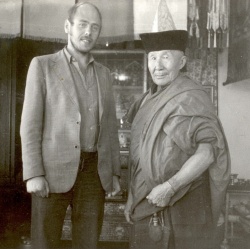Difference between revisions of "Relations with the Ivolga Monastery in Buryatia"
(Created page with "thumb|250px|Vello Väärtnõu and Guru Munko Lama in Ivolga Monastery Lamas from the Ivolga Monastery made major contributions to the development of ...") |
|||
| Line 1: | Line 1: | ||
[[File:VV_and_Munko.jpg|thumb|250px|Vello Väärtnõu and Guru Munko Lama in Ivolga Monastery]] | [[File:VV_and_Munko.jpg|thumb|250px|Vello Väärtnõu and Guru Munko Lama in Ivolga Monastery]] | ||
| − | Lamas from the Ivolga Monastery made major contributions to the development of Estonian Buddhism. From 1978–1986, Väärtnõu studied Buddhist philosophy, psychology, rituals, architecture and Tibetan medicine under the guidance of famous teachers of the Ivolga Monastery: Hambo Lama Munko Tsybikov, Hambo Lama Zhimba Erdineev and many others. All that was learnt was put to use in Estonia. During that time, lamas from the Ivolga Monastery started to visit Estonia regularly. Because of Soviet control, these Buddhist activities were kept secret, and the general public in Estonia never heard of such activities; public exposure would have also been bad for the Ivolga Monastery. The Brotherhood visited the Ivolga Monastery on several occasions and took thangkas and statues made in Estonia to the Ivolga Monastery, and these were thought to be of great value there. All the ritual objects in Taola were brought from Ivolga and prayer drums were made locally in Estonia. In Ivolga, they copied manuscripts and texts, and photographed a great number of thangkas and burhans. Unfortunately, the KGB later confiscated all of these precious slides and microfilms. | + | [[Lamas]] from the [[Ivolga Monastery]] made major contributions to the development of Estonian [[Buddhism]]. From 1978–1986, Väärtnõu studied [[Buddhist philosophy]], {{Wiki|psychology}}, [[rituals]], architecture and [[Tibetan medicine]] under the guidance of famous [[teachers]] of the [[Ivolga Monastery]]: Hambo [[Lama]] Munko Tsybikov, Hambo [[Lama]] Zhimba Erdineev and many others. All that was learnt was put to use in {{Wiki|Estonia}}. During that [[time]], [[lamas]] from the [[Ivolga Monastery]] started to visit {{Wiki|Estonia}} regularly. Because of Soviet control, these [[Buddhist]] [[activities]] were kept secret, and the general public in {{Wiki|Estonia}} never [[heard]] of such [[activities]]; public exposure would have also been bad for the [[Ivolga Monastery]]. The Brotherhood visited the [[Ivolga Monastery]] on several occasions and took [[thangkas]] and [[statues]] made in {{Wiki|Estonia}} to the [[Ivolga Monastery]], and these were [[thought]] to be of great value there. All the [[ritual]] [[objects]] in Taola were brought from Ivolga and [[prayer]] drums were made locally in {{Wiki|Estonia}}. In Ivolga, they copied manuscripts and texts, and photographed a great number of [[thangkas]] and burhans. Unfortunately, the KGB later confiscated all of these [[precious]] slides and microfilms. |
{{R}} | {{R}} | ||
Latest revision as of 05:16, 17 September 2013
Lamas from the Ivolga Monastery made major contributions to the development of Estonian Buddhism. From 1978–1986, Väärtnõu studied Buddhist philosophy, psychology, rituals, architecture and Tibetan medicine under the guidance of famous teachers of the Ivolga Monastery: Hambo Lama Munko Tsybikov, Hambo Lama Zhimba Erdineev and many others. All that was learnt was put to use in Estonia. During that time, lamas from the Ivolga Monastery started to visit Estonia regularly. Because of Soviet control, these Buddhist activities were kept secret, and the general public in Estonia never heard of such activities; public exposure would have also been bad for the Ivolga Monastery. The Brotherhood visited the Ivolga Monastery on several occasions and took thangkas and statues made in Estonia to the Ivolga Monastery, and these were thought to be of great value there. All the ritual objects in Taola were brought from Ivolga and prayer drums were made locally in Estonia. In Ivolga, they copied manuscripts and texts, and photographed a great number of thangkas and burhans. Unfortunately, the KGB later confiscated all of these precious slides and microfilms.
